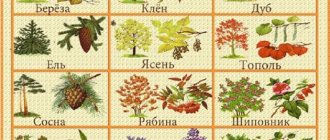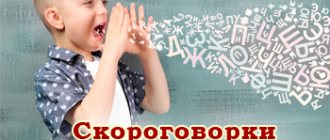Didactic games (verbal) for children 5-6 years old
Didactic games (verbal) for older preschoolers
Author : Pashkova Larisa Aleksandrovna, teacher of speech therapy group, MBDOU "Shegarsky kindergarten No. 1 of a combined type" Games can be used in the learning process, in educational work.
This material is recommended for teachers of various types of institutions, including additional education, educators, and teachers. The games are intended for older children. Games were used in the form of separate activities, games and exercises. Game "Carpenter"
Target. We develop children's imagination and verbal creativity; We teach what tools a carpenter uses when working. Description of the game. The presenter asks the children riddles on a given topic. For quick and correct answers, players are given chips. And at the end of the game, when counting, the most savvy one receives a prize. He bows, he bows, When he comes home he will stretch out. (Axe) A toothy animal gnaws an oak tree with a whistle. (Saw) The fat one will beat the thin one, the thin one will beat something. (Hammer and nail) Wooden river, Wooden boat, And above the boat Wooden smoke flows. (Plane)
Game "Fun Olympics"
Target. We teach children to solve riddles, strengthen speech skills - evidence, develop speech skills - description. Description of the game. Children are divided into two teams. Each team comes up with a name for itself. Teams compete to solve riddles about sports. Players must correctly guess the riddle and prove the answer if they can beat it. For each correct answer, the team receives an Olympic ring (hoop). The first team to collect 5 rings is declared the winner. Small in stature, but brave, he galloped away from me. (Ball) A white goose is swimming - The belly is wooden, The wing is linen. (Yacht) The river is flowing - we are lying, Ice on the river - we are running. (Skates) Wooden horses gallop in the snow, but don’t fall into the snow. (Skis) When spring takes its toll, And the streams run ringing, I jump over it, And she jumps over me. (Jump rope) Legs are moving along the road And two wheels are running. The riddle has an answer: This is my... (Bicycle)
Game "Sounds Mixed Up"
Target. Preparing children for sound analysis; We develop auditory and visual memory. Description of the game. The presenter reads funny poems, deliberately making mistakes in the words. The child names the word correctly and says what sounds the pairs of words differ in. I found a plum... blouse, Fenya put on... a bone. Ripened on the tree... a caftan, In winter I put on... a chestnut. The count sat on a tree, and the rook lives in a beautiful house. The children grew green in the park, and the branches went out for a walk. Cats fly in the forest in the summer, hunt mice... midges. The pussy has clawed... slippers, Vika has brand new... paws. I have a long way to go... stump, I'd rather sit on... laziness.
Game "Additions"
Target. Develops children's speech creativity. Description of the game. The presenter reads poetry without the last word. Children must quickly find the right word. For each correct answer, the child receives a chip. The winner will be the one with the most chips. From the sky all the fluffs glide - Silvery... (snowflakes) Architects are creators Build wonderful... (palaces) Once upon a time there was a cheerful gnome. He built in the forest... (house) In this house, you trust me, Locked securely... (door) The crust of snow has hardened, Ours will be slippery... (slide) The baby has a rattle Very noisy... (toy) Our children know: Hide and seek is the best … (a game)!
We recommend watching:
Didactic games with sand for children 3-4-5 years old
Didactic game for preschoolers 5-6 years old “Find the differences” Didactic game for children of the older group. Types of work Didactic game on cognitive development for children 6-7 years old
Similar articles:
Didactic game “Collect a caterpillar” for children 5-6-7 years old
Didactic game “Find a Pair” for children 3-4 years old
Didactic game "Flowers" for children 5-6-7 years old
Didactic game for the development of fine motor skills of children 3 – 7 years old
Didactic game for preschoolers. Formation of ideas about time
Progress of the game. The presenter explains what the children will have to finish
sentences that the presenter will begin to speak using the word “because
What". You can select several options for one start
proposals, the main thing is that they all correctly reflect the reason
events described in the first part. For every correctly completed
continuation players receive a chip. The one who collects wins
more chips.
"Unravel the Words "
Goal: learn to compose sentences using these words .
Development of speech in preschoolers through word games
Development of speech in preschoolers through word games.
Preschool age is a period of active assimilation by a child of spoken language, the development of all aspects of speech. Coherent speech in children is imperfect, stories are inconsistent. It is important to teach the child to clearly express his thoughts and desires in words and sentences. In the game, the child is fluent in speech, says what he thinks , and not what is needed. There are no schemes in the game, nothing fetters the child. It is necessary to develop children’s speech and form verbal communication. The greatest effect of work on the development of a preschooler’s speech will be obtained if it is carried out through a variety of games. One of the types of games is verbal a game.
Word games are built on the words and actions of the players. In such games, children learn, based on existing ideas about objects, to deepen their knowledge about them, since in these games it is necessary to use previously acquired knowledge in new connections, in new circumstances. Solve a variety of mental problems; describe an object, highlighting its characteristic features; guess from the description; find signs of similarities and differences; group objects according to various properties and characteristics. These games are of great importance for the development of a child’s thinking, since in them children learn to express independent judgments, draw conclusions and conclusions, without relying on the judgments of others, and to notice logical errors. When playing such games, children develop speech.
Verbal games develop children's speech and thinking, fantasy and imagination. Verbal games do not require any props; you can play them on the way to kindergarten, in line or while traveling in public transport.
Verbal games have the goal of developing and shaping children’s thinking in an accessible, entertaining way. Word games can be divided into four groups. In each group, common mental tasks are defined.
1. Games that develop the ability to identify essential features of objects and phenomena.
"Guess it"
. Purpose of the game. To teach to describe an object without looking at it, to find significant features in it; recognize an object by description. “Metal, made of twigs, stands on the windowsill, from there you can hear the singing of a bird,” “White, electric, the lid opens, a red light is on on the side, stands on a stand, water is boiling in it.”
“What kind of bird (animal) is this?”
Purpose of the game. Learn to describe the characteristic features of birds and animals and recognize them by description. “This is a big bird, there are spurs on its legs, a red comb on its head, a yellow beak, a beautiful tail, it wakes you up in the morning.”
"Not really"
. Purpose of the game. Teach children to think, pose questions logically, and make correct conclusions. The driver goes out the door. Children choose an item. They can only answer the driver’s questions: “Yes” or “No.” The driver asks: “Is this object on the floor?” - "No". "On the wall?" - "No. "On the shelf?" - "Yes". “Is it glass?” - "Yes". “Is this a vase?” - "Yes".
"Shop"
. Purpose of the game. Learn to describe an object, find its essential features, recognize an object by description.
The children sit in a semicircle, on the table there is a shelf with toys. The seller is one of the children. The teacher first addresses him: “I want to buy a toy from you. It’s round, rubbery, can jump, and both kids and adults love to play with it.” (Game conditions: you cannot look at the toy you want to buy.)
"Radio"
. Purpose of the game. Develop the ability to be observant and activate children’s speech. The announcer (vocabulary work - who is this?) will describe someone from our group, and from his story we will find out who it is. (The boy is lost. He has short hair, jeans, a sweater with a red car on it.)
“Where was Petya?”
. Purpose of the game. Learn to describe people’s work, guess from the description what children are talking about. (Petya looked into the spacious, bright room, where children were singing, dancing, and someone was playing the piano).
2. Games that teach children the ability to compare, contrast, notice illogicalities, and make correct conclusions.
"Make up a story"
. Purpose of the game. Teach children to invent their own fables, including them in their stories, to develop children’s imagination. “A girl was walking through the forest. She had a magic basket in her hands. The girl picked a strawberry, put it in a basket, and moved on. I found another berry. I wanted to put it in a basket, but there was no room. The first strawberry grew and took up all the free space. I had to pick the berries with my fist.”
“It’s similar - it’s not similar.”
Purpose of the game. Teach children to compare objects, find signs of differences and similarities in them, and recognize objects by description. “I have two flowers. One with white petals and a yellow center, and the other pink, with beautiful fragrant petals, with thorns.”
“Who will notice more fables?”
. Purpose of the game. Teach children to notice fables, illogical situations, and explain them; develop the ability to distinguish the real from the imagined. Developing coherent, figurative speech in children, developing an understanding of humor, and the ability to make jokes themselves. K.I. Chukovsky "Confusion".
3. Games with the help of which the ability to generalize and classify objects according to various criteria is developed.
"Answer quickly"
. Purpose of the game. Strengthen children's ability to classify objects (by color, shape, size, quality, etc.) and answer quickly.
Ball game. Question: "Green". Quick answer: "Leaf." "Wooden table"
"Stone house".
"Who is bigger?"
Purpose of the game. Teach children to relate people’s actions to their profession, activate their vocabulary, and develop the ability to think quickly. “Children, what do you think is the profession of Tatyana Ivanovna, who cooks cutlets?”
“What does anyone need?”
Purpose of the game. Exercise children in the classification of objects, the ability to name objects necessary for people of a certain profession. “What does a shoemaker need to work?” “Nails, hammer, leather, boots, shoes, car, paw, etc.” - children's answers.
"Tops - roots"
. Purpose of the game. Exercise children in classifying vegetables (based on the principle: what is edible - the root or the fruit on the stem).
“Carrots” - (answer “Roots”).
“Tomato” - “Tops”.
“Onion” - “Roots and Tops”
“Name three objects”
. Purpose of the game. Exercise children in classifying objects.
“What objects can be called in one word “Flowers”, but the condition: you can only name three words. (“Chamomile, dahlia, peony”)
"Hunter"
. Purpose of the game. Continue to practice children in classifying animals, fish, birds, etc. The child walks from mark to mark, saying a word at each step. “I’m going to the forest to hunt, I’ll hunt a fox (step), a hare (step), etc.” The winner is the one who reaches the final mark, pronouncing a new name of the animal with each step; you cannot repeat it.
"Animals, birds, fish"
. Purpose of the game. Strengthen the ability to classify animals, fish, birds. Children pass an object in a circle (from neighbor to neighbor) with the words: “Here is a bird. What kind of bird? and you need to give a quick answer “Eagle”. You can name not only birds, but also animals, insects, and fish.
“Who can name the most objects?”
Purpose of the game. Teach children to classify objects according to their place of production. “What do people grow in the fields?” (potatoes, wheat, rye, etc.)
“Who grew the grain?” (grain grower).
“Who bakes the bread?” (baker).
"Nature and Man"
. Purpose of the game. To consolidate and systematize children’s knowledge about what is created by man and what nature provides. The driver throws the ball and asks the question: “What was created by man?” (children's answers: furniture, factories, etc.). The driver throws the ball and asks the question: “What was created by nature?” (children’s answers, conversations arise about how people use nature, what they do to protect it, etc.)
3. Games that develop speed, flexibility of thinking, sense of humor, and develop self-control.
"Broken phone"
. Purpose of the game. Develop auditory attention. Quietly pronounce in the neighbor’s ear the word that the first participant heard from the driver.
"It flies - it doesn't fly"
. Children raise their hand if the named object flies or are silent if it does not fly.
"Paints"
. Purpose of the game. Develop auditory attention and quick thinking. Driver Senka Popov. The owner decides who will use which paint. Senka Popov comes for paint. Conducts a dialogue with the owner of the paints. If the paint he needs is there, he takes it away; if not, he moves aside. Then he returns. The game repeats itself.
“We won’t say where we were”
. Purpose of the game. Cultivate resourcefulness, intelligence, and the ability to transform. One group depicts a well-known activity that the children observed, the other group guesses. (Shine shoes, wash dishes, read books, play an orchestra or a separate musical instrument, etc.).
"Vice versa"
. Purpose of the game. Cultivate quick thinking in children. Ball game. Name antonyms. (Forward - back; inside - outside; left - right; tie - untie, etc.).
"Add a syllable"
. Purpose of the game. Develop phonemic awareness.
“Add sentence”
. Purpose of the game. Develop speech activity.
“Say the words with the right sound”
. Purpose of the game. Develop phonemic awareness and quick thinking.
“Say it differently”
. Purpose of the game. Learn to select synonyms. Big – huge, large, enormous, gigantic. Wet - damp, damp.
"Choose a word"
.
Purpose of the game. Develop flexibility of thinking, the ability to select the right words according to their meaning. “What can you sew?”
(dress, jacket, trousers, skirt, coat, sundress, boots, fur coat, etc.).
“What can you tie?”
(bow, laces, rope, scarf, ties).
“Who knows, let him keep counting”
. Purpose of the game. Consolidating knowledge of ordinal counting within 10, developing quick thinking and auditory attention.
“When does this happen?”
. Purpose of the game. Clarify and deepen knowledge about the seasons.
“When do there be a lot of yellow leaves?” “What happens in the spring?” etc.
4. Games that help develop the ability to generalize and classify objects according to various criteria.
"Answer quickly"
. Purpose of the game. Strengthen children's ability to classify objects (by color, shape, size, quality, etc.) and answer quickly.
Ball game. Question: "Green". Quick answer: "Leaf." "Wooden table"
"Stone house".
"Who is bigger?"
Purpose of the game. Teach children to relate people’s actions to their profession, activate their vocabulary, and develop the ability to think quickly. “Children, what do you think is the profession of Tatyana Ivanovna, who cooks cutlets?”
“What does anyone need?”
Purpose of the game. Exercise children in the classification of objects, the ability to name objects necessary for people of a certain profession. “What does a shoemaker need to work?” “Nails, hammer, leather, boots, shoes, car, paw, etc.” - children's answers.
"Animals, birds, fish"
. Purpose of the game. Strengthen the ability to classify animals, fish, birds. Children pass an object in a circle (from neighbor to neighbor) with the words: “Here is a bird. What kind of bird? and you need to give a quick answer “Eagle”. You can name not only birds, but also animals, insects, and fish.
“Who can name the most objects?”
Purpose of the game. Teach children to classify objects according to their place of production. “What do people grow in the fields?” (potatoes, wheat, rye, etc.)
“Who grew the grain?” (grain grower).
“Who bakes the bread?” (baker).
"Nature and Man"
. Purpose of the game. To consolidate and systematize children’s knowledge about what is created by man and what nature provides. The driver throws the ball and asks the question: “What was created by man?” (children's answers: furniture, factories, etc.). The driver throws the ball and asks the question: “What was created by nature?” (children’s answers, conversations arise about how people use nature, what they do to protect it, etc.)
"Tops - roots"
. Purpose of the game. Exercise children in classifying vegetables (based on the principle: what is edible - the root or the fruit on the stem).
“Carrots” - (answer “Roots”).
“Tomato” - “Tops”.
“Onion” - “Roots and Tops”
“Name three objects”
. Purpose of the game. Exercise children in classifying objects.
“What objects can be called in one word “Flowers”, but the condition: you can only name three words. (“Chamomile, dahlia, peony”)
In verbal didactic play, children learn to think about things that they do not directly perceive at the moment. Any game teaches you to rely in solving a problem on the idea of previously perceived objects.
A verbal didactic game is an accessible, useful, effective method of developing independent thinking in children. A verbal game does not require special material or certain conditions, but only requires the teacher’s knowledge of the game itself. When conducting games, it is necessary to take into account that the proposed games will contribute to the development of independence and thinking only if they are carried out in a certain system and sequence. A properly organized game promotes the development of coherent, dialogical speech, teaches you to change the timbre and rhythm of speech, teaches you to coordinate movements with words, and teaches you to listen to your interlocutor - a participant in the game.
Progress of the game. The child is read the text of a fairy tale and asked to write it down.
using drawings. Thus, the child himself makes a series
consecutive pictures , based on which he then tells a fairy tale.
The story should be short.
Of course, you can help the child, show how schematically
draw a person, a house, a road; determine with him what
the episodes of the fairy tale must be depicted, i.e., the main ones must be highlighted
plot twists.
15
"How do you know?"
Goal: to teach how to select evidence when writing stories,
choosing essential features.
Progress of the game. In front of the children there are objects or pictures that
they have to describe. The child chooses any object and names it.
The presenter asks: “How did you know it was a TV?”
playing
must describe the subject, choosing only essential features,
distinguishing this item from the rest. For each correctly named
the sign gets a token. The one who collects the most chips wins.
“What doesn’t happen in the world”
Goal: to teach how to find and discuss errors when examining
ridiculous pictures.
Progress of the game. After looking at the absurd pictures , ask the child not to
just list the wrong places, but also prove why this
the image is wrong. Then you get a complete description of the picture , yes
also with elements of reasoning.
"Raise the Number"
Goal: to teach how to determine the number of words in a sentence by ear.




